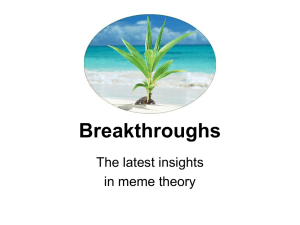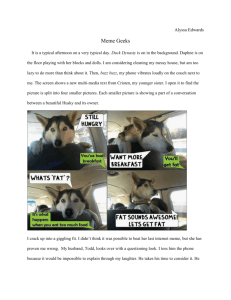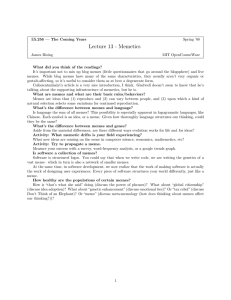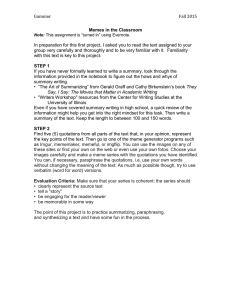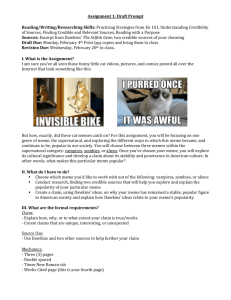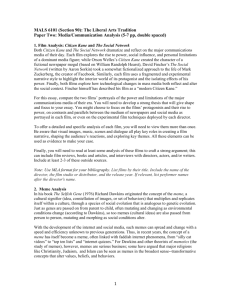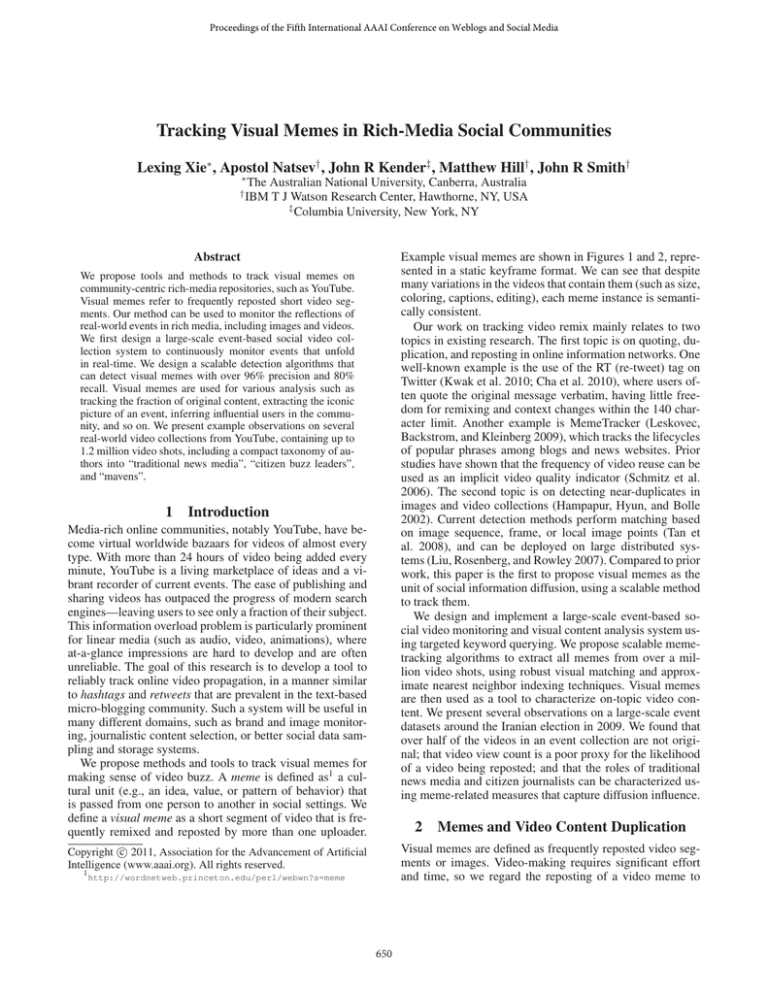
Proceedings of the Fifth International AAAI Conference on Weblogs and Social Media
Tracking Visual Memes in Rich-Media Social Communities
Lexing Xie∗ , Apostol Natsev† , John R Kender‡ , Matthew Hill† , John R Smith†
∗
†
The Australian National University, Canberra, Australia
IBM T J Watson Research Center, Hawthorne, NY, USA
‡
Columbia University, New York, NY
Example visual memes are shown in Figures 1 and 2, represented in a static keyframe format. We can see that despite
many variations in the videos that contain them (such as size,
coloring, captions, editing), each meme instance is semantically consistent.
Our work on tracking video remix mainly relates to two
topics in existing research. The first topic is on quoting, duplication, and reposting in online information networks. One
well-known example is the use of the RT (re-tweet) tag on
Twitter (Kwak et al. 2010; Cha et al. 2010), where users often quote the original message verbatim, having little freedom for remixing and context changes within the 140 character limit. Another example is MemeTracker (Leskovec,
Backstrom, and Kleinberg 2009), which tracks the lifecycles
of popular phrases among blogs and news websites. Prior
studies have shown that the frequency of video reuse can be
used as an implicit video quality indicator (Schmitz et al.
2006). The second topic is on detecting near-duplicates in
images and video collections (Hampapur, Hyun, and Bolle
2002). Current detection methods perform matching based
on image sequence, frame, or local image points (Tan et
al. 2008), and can be deployed on large distributed systems (Liu, Rosenberg, and Rowley 2007). Compared to prior
work, this paper is the first to propose visual memes as the
unit of social information diffusion, using a scalable method
to track them.
We design and implement a large-scale event-based social video monitoring and visual content analysis system using targeted keyword querying. We propose scalable memetracking algorithms to extract all memes from over a million video shots, using robust visual matching and approximate nearest neighbor indexing techniques. Visual memes
are then used as a tool to characterize on-topic video content. We present several observations on a large-scale event
datasets around the Iranian election in 2009. We found that
over half of the videos in an event collection are not original; that video view count is a poor proxy for the likelihood
of a video being reposted; and that the roles of traditional
news media and citizen journalists can be characterized using meme-related measures that capture diffusion influence.
Abstract
We propose tools and methods to track visual memes on
community-centric rich-media repositories, such as YouTube.
Visual memes refer to frequently reposted short video segments. Our method can be used to monitor the reflections of
real-world events in rich media, including images and videos.
We first design a large-scale event-based social video collection system to continuously monitor events that unfold
in real-time. We design a scalable detection algorithms that
can detect visual memes with over 96% precision and 80%
recall. Visual memes are used for various analysis such as
tracking the fraction of original content, extracting the iconic
picture of an event, inferring influential users in the community, and so on. We present example observations on several
real-world video collections from YouTube, containing up to
1.2 million video shots, including a compact taxonomy of authors into “traditional news media”, “citizen buzz leaders”,
and “mavens”.
1
Introduction
Media-rich online communities, notably YouTube, have become virtual worldwide bazaars for videos of almost every
type. With more than 24 hours of video being added every
minute, YouTube is a living marketplace of ideas and a vibrant recorder of current events. The ease of publishing and
sharing videos has outpaced the progress of modern search
engines—leaving users to see only a fraction of their subject.
This information overload problem is particularly prominent
for linear media (such as audio, video, animations), where
at-a-glance impressions are hard to develop and are often
unreliable. The goal of this research is to develop a tool to
reliably track online video propagation, in a manner similar
to hashtags and retweets that are prevalent in the text-based
micro-blogging community. Such a system will be useful in
many different domains, such as brand and image monitoring, journalistic content selection, or better social data sampling and storage systems.
We propose methods and tools to track visual memes for
making sense of video buzz. A meme is defined as1 a cultural unit (e.g., an idea, value, or pattern of behavior) that
is passed from one person to another in social settings. We
define a visual meme as a short segment of video that is frequently remixed and reposted by more than one uploader.
2
Visual memes are defined as frequently reposted video segments or images. Video-making requires significant effort
and time, so we regard the reposting of a video meme to
c 2011, Association for the Advancement of Artificial
Copyright Intelligence (www.aaai.org). All rights reserved.
1
Memes and Video Content Duplication
http://wordnetweb.princeton.edu/perl/webwn?s=meme
650
8
8
71
6
57
71
23
57
57
6
71
8
8
8
71
61
57
8
7
1
57
71
2
7
21
71
8
8
87264257 67656
73875857!576
57 57685
7
71
6
7
8
71
47
1
28
7
47
8
2656789715
878
4583577366
8
71
22
47
71
69
47
67
1
8
8
8
75587
685745
57
1
47
6211
6111
511
411
311
211
1
47
45 67897
5
8
Number1of23uploaded
videos
containing “visual memes”
Figure 1: Two YouTube videos that share multiple different
Figure 2: Meme videos on the Iran3 topic: representative visual
memes. Note that it is impossible to tell from metadata that they
shared content, and that the appearance of the remixed shots (bottom row) has large variations.
memes on a timeline, June-August 2009.
each unique video, we segment shots, extract keyframes, and
extract visual features from each keyframe. We also extract
information from the associated metadata, such as author,
publish date, view counts, and free-text title and descriptions.
Figure 2 illustrates the volume of meme videos (unique
videos containing one or more memes) for the Iranian Politics topic (dataset Iran3 in Table 1). There are hundreds
to thousands per day, with three prominent peaks in JuneAugust 2009 corresponding to important events in the real
world2 . The first mid-June peak reflects a highly controversial election prompting massive protests and violent clashes.
A second mid-June peak captures the virality of an amateur
video on the shooting of Neda Soltan, which became the
symbol for the whole event. A third peak in mid-July corresponds to a Friday prayer sermon that drew over 2 million
people, an event described as “the most critical and turbulent
Friday prayer in the history of contemporary Iran”2 .
be a much stronger endorsement requiring much more effort
than simply viewing, commenting on, or linking to the content. In this paper, we will use “meme” in two ways: singularly, to refer to individual video segment instances, which
are visualized as representative icons (as in Figure 2), and
collectively, to refer to the entire equivalence class of reposted near-duplicate video segments, which are visualized
as sets of similar keyframes (such as the linked frames in
Figure 1). This dual use reflects the observation that users
tend not to repeat others’ entire videos unaltered, but neither do they often create highly edited original stories. The
unit of interaction appears to be video segments, consisting
of one or a few contiguous shots, with only minor modifications such as video formatting changes (aspect ratio, color,
contrast, gamma), and video production edits (the superimposition of text, captions, borders, transition effects).
A visual meme is a basic unit of information that propagates through the video information network relatively intact. Compared to a user tag or hashtag, it is a representation of a specific idea rather than an overall topic. Compared to a re-tweet that repeats a short message verbatim,
it carries forward part of the idea and often remixes with
new ones. Its closest analogy in textual media is the meme
phrase (Leskovec, Backstrom, and Kleinberg 2009).
3
4
Scalable Visual Meme Detection
There are two main challenges in detecting visual memes in
a large collection. The first is the noise in matching video
segments, since remixed online video segments tend to vary
widely in appearance (Section 2). The second is the overall computational complexity of the matching. Finding all
pairs of near-duplicates by matching all N shots against each
other has a complexity of O(N 2 ), which is infeasible for a
typical collection containing millions of video shots.
Our solution to the first challenge is robust keyframe
matching, where a keyframe is representative of a video
shot, segmented using temporal feature differences. We preprocess the frame by removing trivial (e.g. blank) matches.
we then extract the color correlogram (Huang et al. 1999)
feature for each frame to capture the local spatial correlation of pairs of colors. The color correlogram is rotation, scale-, and to some extent, viewpoint-invariant. We also
use a “cross”-layout that extracts the descriptor only from
horizontal and vertical central image stripes, thereby emphasizing the center portion of the image and disregard-
Monitoring Events on YouTube
It is impossible to externally monitor all YouTube content.
Instead, we use a few generic, time-insensitive text queries
as pre-filters to narrow down the content scope. The queries
are manually designed to capture a generic topic theme, as
well as any generally understood cause, phenomena, and
consequences of the topic. For example, our query on the
“global warming” topic consists of global warming, climate
change, green house gas, CO2 emission, and so on. We have
aimed to create queries covering the main invariant aspects
of a topic, but automatic time-varying query expansion is
open for future work. We use the YouTube API to query and
extract as many available videos for each query that the API
will allow. We filter the results to remove videos that have responded to multiple queries, or those whose YouTube identifier match one that had previously been gathered. Then, for
2
See timeline: http://en.wikipedia.org/wiki/Timeline_of_
the_2009_Iranian_election_protests
651
ing the corners. This layout improves robustness with respect to text and logo overlay, borders, crops, and shifts.
The keyframe matching uses a query-adaptive threshold to
normalize among the query frame, and among the different
feature dimensions. This threshold is tuned on a training set.
Our solution to the complexity challenge is to use an indexing scheme for fast approximate nearest neighbor (ANN)
look-up. We use the FLANN Library (Muja and Lowe 2009)
to automatically select the best indexing structure and its appropriate parameters for a given dataset. Our frame features
have over 300 dimensions, and we empirically found that
setting
√ the number of nearest-neighbor candidate nodes m
with approximately
to N can approximate k-NN results
√
0.95 precision. In running in O(N N ) time, it achieves two
to three decimal orders of magnitude speed-up over exact
nearest neighbor search. Furthermore, each FLANN query
results in an incomplete set of near-duplicate pairs, we perform transitive closure on the neighbor relationship to find
equivalence classes of near-duplicate sets. We use an efficient set union-find algorithm that runs in amortized time of
O(E), where E is the number of matched
pairs (Galler and
√
Fisher 1964), which is again O(N N ).
5
Intuitively, this influence index gives a higher score to a
video containing a very popular meme that was uploaded
early.
6
#videos #authors #shots
upload time
Iran3
23,049 4,681 1,255,062 08/07∼08/09
Iran1
5,429
2,393
210,259 09/07∼07/09
Housing 2,446
654
71,872 08/07∼08/09
topic
Using Memes to Estimate Influence
One application for visual memes is in estimating the impact
of content and of authors within a content sharing network.
Visual memes can be viewed as links between videos and
their creators that share the same unit of visual expression.
We derive a link-based measure, called diffusion influence
index, to depict the influence of a meme and its author.
Denote a video (or multimedia document) as di in event
collection D, with i = 1, . . . , N . Each video is authored
(i.e., uploaded) by author a(di ) at time t(di ), with a(di ) taking its value from a set of authors A = {ar , r = 1, . . . , R}.
Each video document di contains a collection of memes,
{m1 , m2 , . . . , mKi } from a meme dictionary M. We compute the in-degree (and out-degree) of each meme m in
video di , as the number of other videos containing meme
m that appeared before (and after) di .
in
= Σj I{m ∈ dj , t(dj ) < t(di )}
ζi,m
out
ζi,m
Table 1: Summary of YouTube event data sets.
Meme detection performance
On the Iran3 set of over 1 million shots, feature extraction takes around 7 hours on a quad-core CPU, and indexing and querying with FLANN takes 5 to 6 CPU hours.
We measure the meme detection performance using ground
truth from the Housing dataset, which contains ∼ 15, 000
near-duplicate keyframe pairs and ∼ 25, 000 non-duplicate
keyframe pairs, sampled from multiple runs of k-means
clustering and nearest-neighbor search. Each pair was manually verified, and the collection specifically includes many
pairs near the decision boundary. We compute the nearduplicate equivalence classes as described in Section 4, and
calculate precision (P) and recall (R) on the labeled pairs.
The results are shown on Figure 3 left for varying values of the threshold parameter τ . We note that the performance is generally quite high with P > 95%. For the rest
of our analysis, we use an operating point with high recall
P = 96.6%, R = 80.7%.
(1)
= Σj I{m ∈ dj , t(dj ) > t(di )}
where I{·} is the indicator function that takes a value of 1
in
when its argument is true, and 0 otherwise. Intuitively, ζi,m
out
and ζi,m
captures the number of videos are potential sources
and potential followers for meme m in di . The video influence index χi is defined for each video document di as the
ratio of its out-degree over its in-degree, aggregated over all
memes (Equation 2). The smoothing constant in the denominator accounts for di itself. The total author influence index
χ̂r is the aggregate χi over all videos from author ar (Equation 3).
χi
=
Σm
out
ζi,m
in
1 + ζi,m
(2)
χ̂r
=
Σ{i,a(di )=ar } χi
(3)
Experiments and Observations
We present example observations on three test datasets, collected from YouTube using the targeted-querying and collection procedures described in Section 3. Table 1 contains
an overview of the datasets. The Iran3 set is about Iranian
domestic politics and related international events during the
3-month period of summer 2009. The Iran1 set is a subset
of Iran3 that was collected during the first of the 3 months;
most of its videos are about the election in mid-June and its
associated political outbreaks. The Housing set is about the
housing market in the 2008-09 economic crisis; this handannotated set was used as a validation set for tuning the visual meme detection algorithms. We perform visual meme
detection as described in Section 4. We additionally filter
the meme clusters identified by the detection system, by removing singletons belonging to a single video or a single
author.
Content views and re-posting probability
In our video collections, the behavior of remixing and reposting is quite dominant – over 58% of the videos and 70%
of the authors contain visual memes for Iran3. However,
we observe that video popularity is a poor indicator of how
likely it is to be re-posted. In the Iran3 set of more than 23K
videos, for example, the four most popular videos have no
memes and have nothing to do with the topic, and likewise
for 7 of the first 10. One has to get beyond the first 1,600
652
precision
1.00
0.99
0.98
P=0.997, R=0.735
F1=0.88
P=0.982, R=0.801
traditional
news media
Chosen operating point
P=0.968, R=0.807
Topic: Iran3
citizen
buzz leaders
maven
0.97
0.96
0.95
0.94
0.00
0.20
0.40
0.60
0.80
1.00
recall
Figure 3: From left to right: Performance of visual meme detection method on the Housing dataset. Video views vs. meme
probability on Iran3 set.
most popular videos before the likelihood of having nearduplicates passes the average for the dataset, at about 0.58
(see Figure 3 middle). There are several reasons for this mismatch. Among the video entries returned by YouTube search
API, the most viewed are often not related to the topic –
the one with the highest view-count is a music video irrelevant to Iranian politics. Such videos also tend to be part of
a production (e.g. promotion for a song), which bears lesser
value for re-posting and re-interpretation. Moreover, it is influenced by a “rich-get-richer” effect due to content recommendations and promotions on YouTube site. In short, popularity is a poor proxy for relevance or importance.
ing, and a scalable algorithm for extracting visual memes
with over 98% precision and 80% recall. We have observed
in real-world youtube collection containing over 1 million
shots, that over half of the videos in typical event collections
contain re-mixed content; video view counts are poorly correlated with the probability of being remixed and reposted.
Visual memes can be used to characterize diffusion influence, such as capturing the roles that citizen journalists and
traditional news media play. Future work includes exploring
the meanings and evolution of memes, or understanding and
predicting visual meme virality.
Diffusion index for content and authors
Cha, M.; Haddadi, H.; Benevenuto, F.; and Gummadi, K.
2010. Measuring user influence in twitter: The million follower fallacy. In ICWSM.
Galler, B. A., and Fisher, M. J. 1964. An improved equivalence algorithm. Commun. ACM 7(5):301–303.
Hampapur, A.; Hyun, K.; and Bolle, R. 2002. Comparison
of sequence matching techniques for video copy detection.
In Conf. on Storage and Retrieval for Media Databases.
Huang, J.; Kumar, S.; Mitra, M.; Zhu, W.; and Zabih, R.
1999. Spatial color indexing and applications. International
Journal of Computer Vision 35(3).
Kwak, H.; Lee, C.; Park, H.; ; and Moon, S. 2010. What is
Twitter, a Social Network or a News Media? . In WWW.
Leskovec, J.; Backstrom, L.; and Kleinberg, J. 2009. Memetracking and the dynamics of the news cycle. In Proc. KDD.
Liu, T.; Rosenberg, C.; and Rowley, H. A. 2007. Clustering
billions of images with large scale nearest neighbor search.
In IEEE Workshop on Applications of Computer Vision, 28.
Muja, M., and Lowe, D. G. 2009. Fast approximate nearest
neighbors with automatic algorithm configuration. In Intl.
Conf. on Computer Vision Theory and Applications.
Schmitz, P.; Shafton, P.; Shaw, R.; Tripodi, S.; Williams, B.;
and Yang, J. 2006. International remix: video editing for the
web. In Proc. ACM Multimedia, 798. ACM.
Tan, H.-K.; Wu, X.; Ngo, C.-W.; and Zhao, W.-L. 2008.
Accelerating near-duplicate video matching by combining
visual similarity and alignment distortion. In Proc. ACM
Multimedia, 861.
References
We compute the diffusion index for authors according to
Equation 3 on dataset Iran3. On the right of Figure 3 we
plot the total diffusion influence χ̂r versus the number of
videos produced by each author. We can see a few distinct
types of contributors. We call one type “maven” (marked in
red), who post only a few videos that tend to be massively
remixed and reposted – this particular maven was among
the first to post the murder of Neda Soltan, and one other
instance of student murder on the street. The former become
the icon of the entire event timeline. A second group can be
dubbed “citizen buzz leaders” (circled in green), who tend to
produce a large number of videos with high total diffusion
factor, yet relatively low influence per video. They aggregate notable content and come relatively late in the timeline,
which is penalized by the influence factor. We examined the
YouTube channel pages for a few authors in this group, and
they seem to be voluntary political activists with screennames like “iranlover100”. Some of their videos are slide
shows of iconic images. Note that traditional news media,
such as AljezeeraEnglish, AssociatedPress and so on (circled in gray) are ranked rather low for this topic, partially
because the Iran government severely limited international
media participation in the event; most of the event buzz was
driven by citizens.
7
Conclusions
In this paper, we proposed using visual memes for tracking and monitoring of social diffusion on YouTube. We described methods and tools for large-scale content monitor-
653

